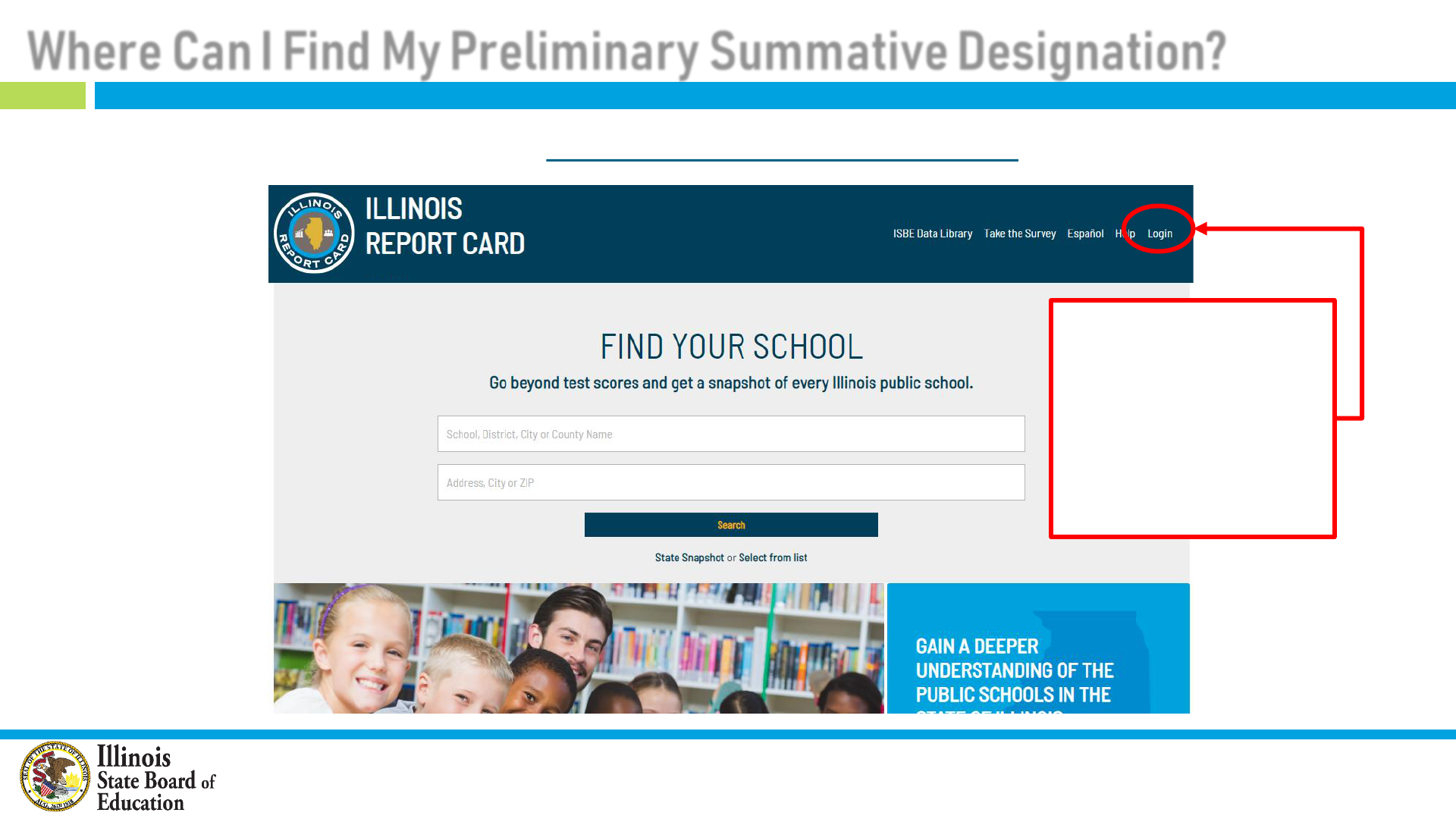
2021
-
22
How to Interpret and
Communicate
Your 2022
Summative Designation
Illinois State Board of Education
October 3 & 4, 2022
Equity ● Quality ● Collaboration ● Community
1

Agenda
❑ Brief Overview of Summative
Designations
❑ Timeline to 2022
❑ Count Down to the Release
❑ Communication Fundamentals
❑ Practitioner Perspectives: Rockford
Public Schools 205
❑ Practitioner Perspectives: Flora
Schools CUSD 35
❑ Interpreting the 2022 Designation
❑ Changes to Accountability in 2022
(that would have impacted
interpretation)
❑ Eligible for Early Exit
❑ Helpful Resources
❑ Using Summative Data to Tell Your
Story
❑ Educator Preview & Report Card
Narratives
❑ www.isbe.net/summative
2

What is an Annual Summative Designation?
3
▪ Multiple measures index of academic achievement and student success
▪ Given annually* and based on the prior year’s performance
▪ Designed to identify schools for support by placing them in school
improvement status
▪ Including schools with student groups needing support in otherwise reasonably
performing schools
▪ A school in school improvement status remains in status for 4 years, regardless
of changes to its annual summative designation during those years in order to
encourage sustainability of progress
*Except in years with a federal waiver of accountability

Four Annual Summative Designations
4
Exemplary
▪ Overall performance in the top 10% of all schools
▪ Must have no targeted student groups at or below the “all students” group of the lowest-performing 5% of schools
▪ High schools must have a graduation rate higher than 67%
Commendable
▪ Overall performance not in the top 10% of all schools
▪ Must have no targeted student groups at or below the “all students” group of the lowest-performing 5%of schools
▪ High schools must have a graduation rate higher than 67%
Targeted
Support
▪ One or more student groups performing at or below the “all students” group of the lowest performing 5 percent of schools;
groups must have at least 20 students in at least five of eight indicators, one of which must be non-academic
A Targeted Support designation initiates targeted school improvementstatus and the school begins a four-year cycle of
school improvement.
Comprehensive
Support
▪ Overall performance in the bottom 5 percent of Title I-eligible schools statewide
▪ All high schools with a graduation rate below 67 percent
A Comprehensive Support designation initiates comprehensive school improvement status and the school begins a four-
year cycle of school improvement.
STUDENT GROUPS
Demographics Programs
▪ American Indian or Alaska Native
▪ Asian
▪ Black or African American
▪ Hispanic or Latino
▪ Native Hawaiian or Other Pacific Islander
▪ Two or More Races
▪ White
▪ Children with disabilities
▪ Economically disadvantaged students
▪ English Learners
▪ Former English Learners

2022 Indicators and Weights
5
Elementary/Middle Band (ES) High School Band (HS)
2022
Data
Chronic
Absenteeism
10%
4, 5, & 6 Year Composite
Graduation Rate
50%
(ELPtP)
English
Learner
Progress to
Proficiency
Composite
4-, 5-, & 6-year
Cohort Graduation
Rate
50%
2022 ONLY
Sci. Participation
2022 ONLY
Sci. Participation

How Did We Get to 2022?
2020 2021 2022
Unprecedented
waivers
of
assessment &
accountability
Majority of schools
open
remote
&
remain
remote
or hybrid
Assessment
given
administrative
flexibility
including
fall testing
January
-
Amendment
submitted to ED
October
– First
designations since
2019
Nationwide
remote
learning
ED offers full
waiver
of accountability
but NO assessment
waiver
Planning
changes
to accountability to
address
anticipated
issues
August
–
Amendment
approved by ED
6
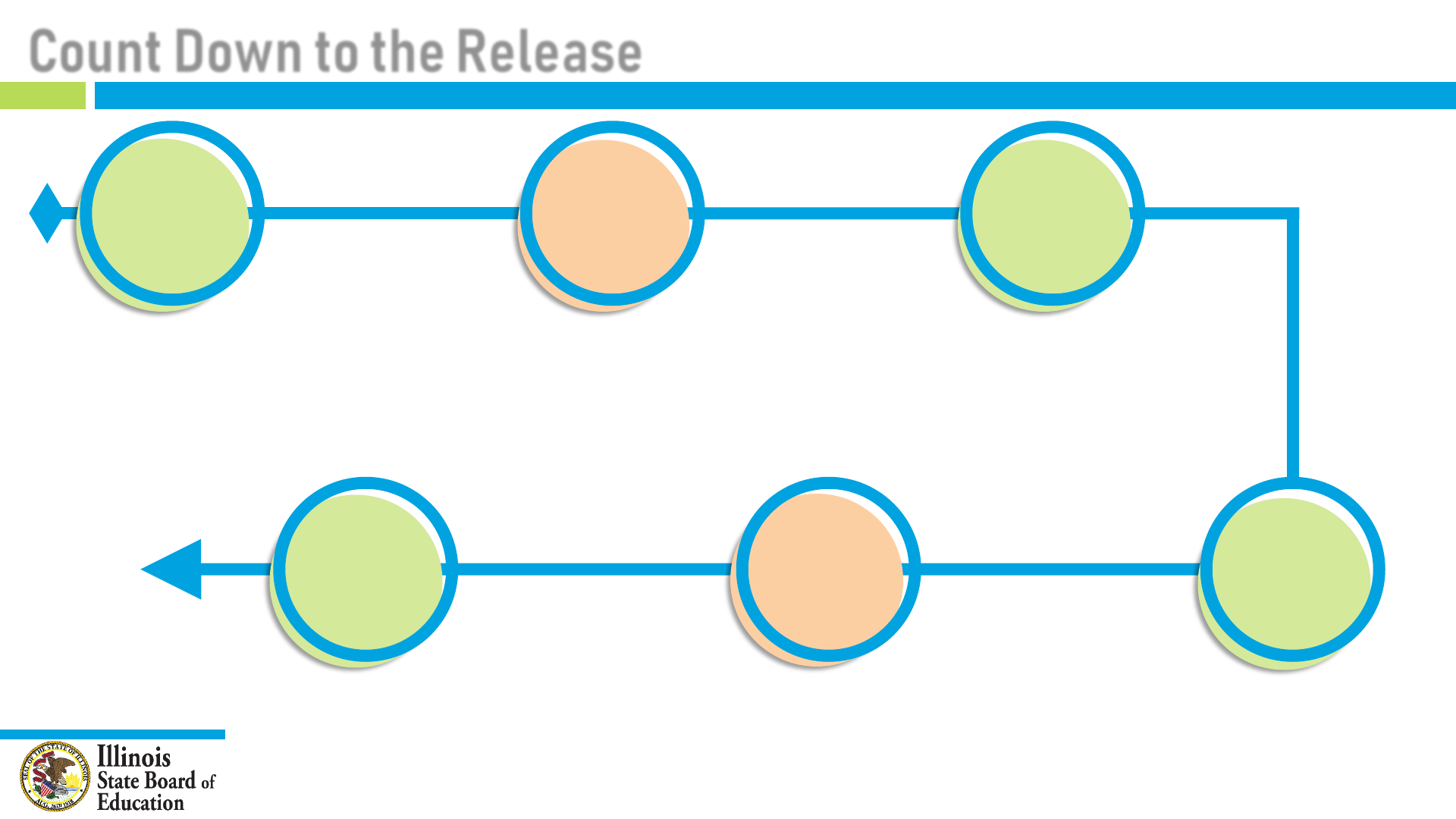
Count Down to the Release
7
OCT
3
OCT
6
~1
week
out
Mid
OCT
~3
days
later
OCT
27
Educator Preview Opens
Preliminary Summative
Designations Available
2022 Report Card
Overview Webinar
Official Summative
Designation
Notification Letters
2022 Grant Notification
Letters to New Targeted &
Comprehensive Schools
Public Data Set Available
Media Briefing Calls
Under Embargo
2022 Report Card
Released
https://www.isbe.net/Documents/2022ReportCard-Timeline.pdf

Six W's of Communication
8
What is the most
important thing for
people to know or
understand?
Who needs to know?
When should the
message be ready?
Where can
information be found?
Where will it be
shared?
Why this designation?
Why will the audience
care?
What will we do now?

The hard part
of initial
communications
1. The original titles of
the two lower
performing
designations
2. Technical Aspects
a. Breadth of the
summative score
metrics
b. Underperforming
subgroups and the
5% line

Communicating with Various Groups
School Leaders: Building-based(site specific and summative report)
and District-level (chart of all designations with supports and tasks)
Board of Education and the media (chart of designations, supports,
and ISBE’s documents)
All of the above received links to ISBE resources including handouts
and webinars
Parents and Families showed little broad-based interest

Lessons Learned
Schedule follow up sessions to understand materials and summative scores
Pre-release communications were too dependent on independent work
Thinking patterns were deeply ingrained from NCLB and the
comprehensive nature of the ESSA accountability system was not yet
prevalent
The action steps to improve results should have been connected to the
release of the designation information and less dependent on the IL
Empower process

Communicating and 2022’s Actions
Highlighted and promoted ISBE-provided materials, including access to in-
person sessions
Chart of designations (funded and current) and supports is included with
more topics covered for each school
We’re not assuming that anyone read anything – training will be more
frequent and more personalized
Focus on what the District is doing about the status rather than the
mechanics of earning the designation
Look for ways to humanize the messages at schools and the districts

13

14

15

16

17

Questions For Colleagues

The Data ≠ The Answer
19
“The data don’t tell you the answer.
The data just tell you where to start asking questions.”
❑ Look for patterns and deviations from the patterns
❑ Look to multiple sources of data
❑ What story do the data tell about being a particular kind of
student at your school?
❑ When in doubt, schedule a data review – (217) 524-1817

Resist Comparing the 2022 Designation to the 2019
20
❑ Resist comparing the 2022 designation to the 2019 designation
❑ Changes with varying degrees of impact to nearly every indicator
❑ Comparison assumes similar conditions & context between the years
❑ Do not over interpret the designation or the data – gauge comparability in context
❑ Did you have high rates of assessment participation in BOTH 2021 and 2022?
❑ Did you make changes to attendance tracking in either 2021 or 2022?
❑ Did you make changes to instructional practices or graduation requirements?
The more stable your circumstances stayed across time, the more comparable your designations are.
However, even if your circumstances stayed the same, other schools' circumstances did not, and the
accountability system is to some degree relational.
If your designation changed, you should carefully consider other sources of data, particularly ones taken
from the current academic year (SY2023) to determine whether you believe this change to be indicative
of a persistent trend, or an anomaly related to conditions in 2021 or 2022.

How to Interpret 2022 Without Comparing to 2019
21
❑ If my 2022 designation is not highly comparable to my 2019 designation,
how can it be interpreted?
❑ The designation is still a common measure of performance across the state on
multiple measures of student success
❑ Students in Exemplary and Commendable schools experience similar levels of
success to their peers on the whole, regardless of demographics
or program status
❑ In Targeted schools, the performance of one or more student groups is
substantively different from their peers
❑ Comprehensive schools need support

How to Interpret 2022 Without Comparing to 2019
22
❑ My designation changed positively, but my overall performance on key
indicators is flat or has declined. How do I explain that?
❑ Multiple changes were made to the accountability system to account for the
impact to schools and students from COVID-19
❑ The purpose of the accountability system is to identify the schools and students
most urgently in need of support
❑ A positive change to the designation with flat or declining performance on specific
metrics reflects needs changing throughout the state

23
Changes in
2022
Summary
2021
-
22

Changes in 2022 Summary – 2 of 5
▪ Two student growth percentiles (SGP) calculations, using the one with
the higher statewide mean
▪ Standard cohort SGP – compares students to their academic peers from the same grade
& subject in the same academic year (i.e. 2022)
▪ New baseline SGP – compares student to their academic peers from the same grade &
subject in a prior baseline academic year (i.e. 2019)
▪ Only interesting when they’re different
▪ One scoring formula for composite 4-, 5-, & 6-year cohort graduation
rate
▪ [Composite weighted cohort graduation rate * 3.7975) – 253.16456]
▪ A weighted composite graduation rate ≥ 93 is 100 points and a weighted composite
graduation rate ≤ 66.667 is 0 points.
25
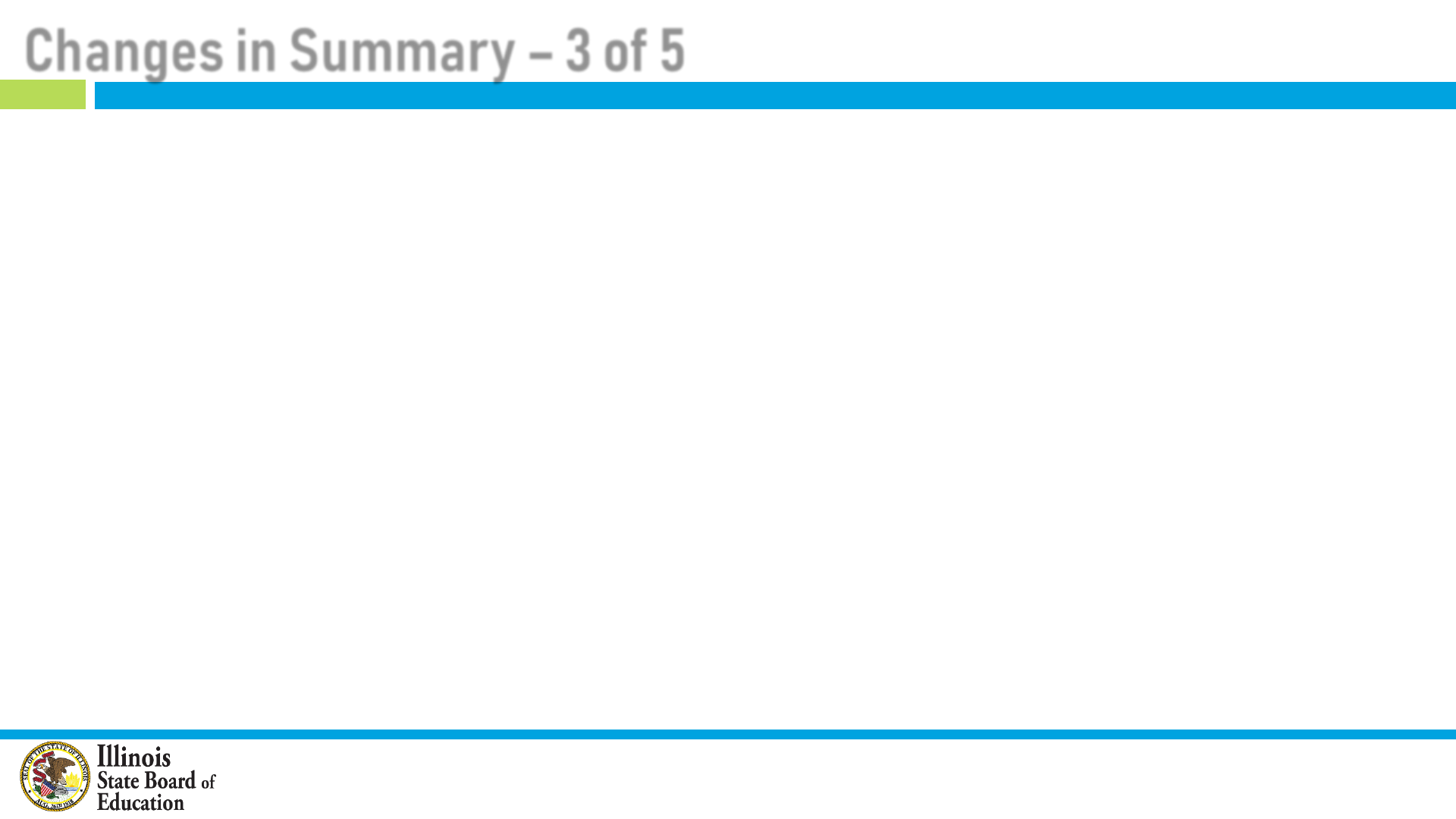
Changes in Summary – 3 of 5
▪ English learner progress to proficiency (ELPtP)
▪ Every EL student in SY2020-21 gets 1 additional year to their timeline (as a “partial
year”)
▪ Using 2020 as the prior score for scale score gain calculation
▪ Functionally excludes students newly identified as ELs in 2021
▪ Differentiated scoring bands for chronic absenteeism
▪ 2022 less than 2021 by more than 7.5 percentage points = 1.25 multiplier
▪ 2022 less than 2021 between 5.01 – 7.5 = 1.2 multiplier
▪ 2022 declined between 2.51 – 5 = 1.15 multiplier
▪ 2022 declined between .01 – 2.5 = 1.1 multiplier
▪ 2022 no more than 5 percentage points = 1.05 multiplier
▪ All else = 1.0 multiplier
26

Changes in 2022 Summary – 4 of 5
▪ Meta-indicator implementation delayed until 2025
▪ Includes college and career readiness, P-2, elementary/middle and fine
arts indicators.
▪ Will validate indicators using 2022, 2023 and 2024 data.
27

Changes in 2022 – Eligible for Early Exit – 5 of 5
28
▪ 2022 holds many uncertainties and changes from the norm
▪ Are rates of chronic absenteeism a persistent trend?
▪ How were growth calculations impacted by missing 2021 priors?
▪ How will going back to 2020 for a prior score for ELPtP impact schools with this
population?
▪ 2022 data simply wasn’t available in time before amendment had to be
submitted to ED
▪ To insulate schools from the effects of these uncertainties, groups of
schools will be eligible for early exit from school improvement status in
2023.
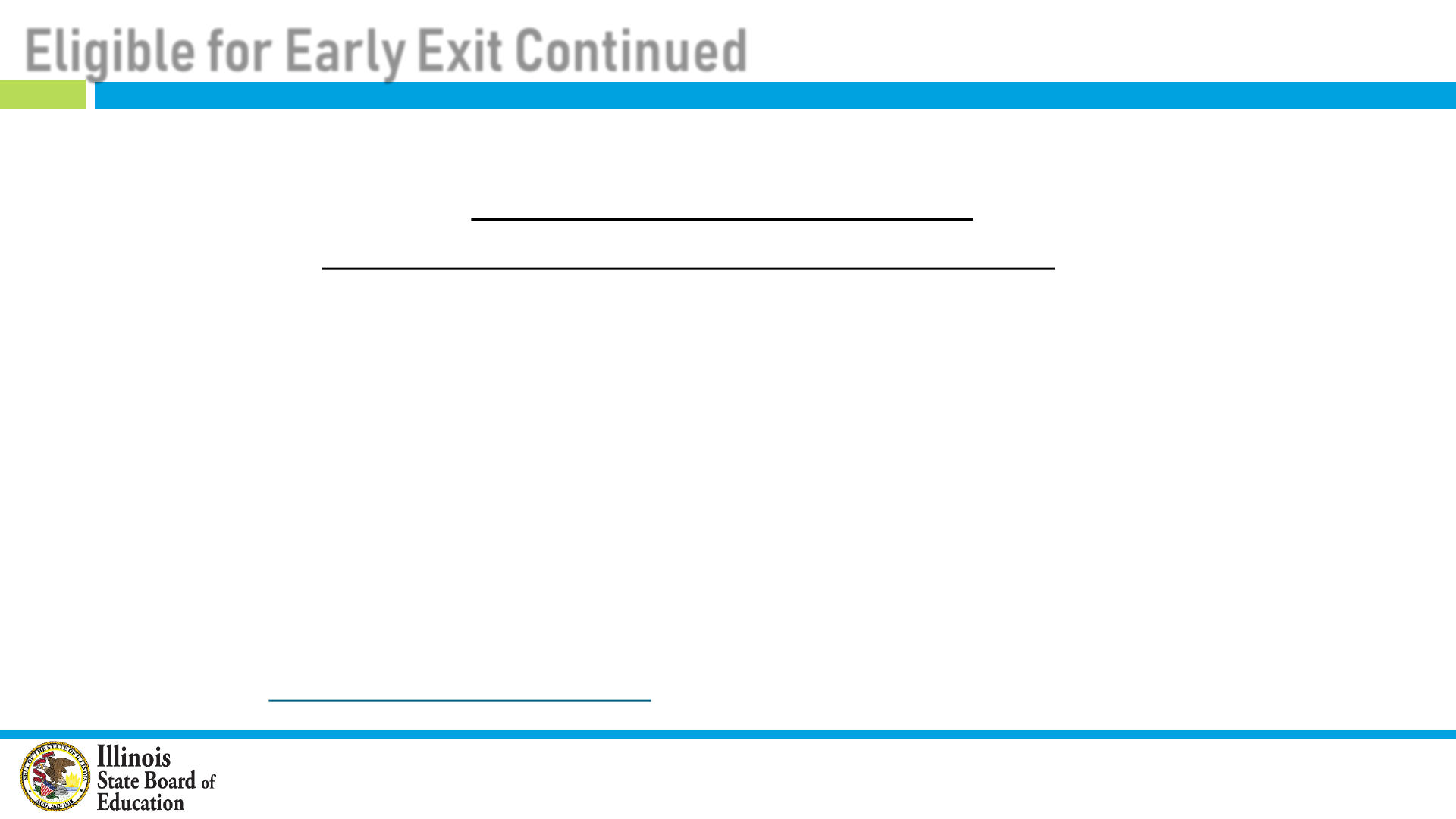
Eligible for Early Exit Continued
29
▪ In order to be eligible for early exit in 2023 a school must:
▪ Have a designation of Commendable or Exemplary in 2023
▪ Have 2023 assessment participation rates ≥95% in ALL SUBJECTS
▪ For the “all students” group and any Targeted student groups
▪ Not already be in school improvement status (i.e. not identified as Targeted or
Comprehensive on Report Card 2018 or 2019).
▪ Be in one of 3 eligibility groups
▪ Schools missing ≥30% of 2021 data
▪ Schools in the top 30% in the state by 2019 index score
▪ Schools where a student group population has shifted by 30% since 2019
[i.e. ≥(2019 * 1.3) or ≤(2019*0.7)]
▪ Check www.isbe.net/summative for a list of eligible schools*
* Eligible schools list will post on October 3

Eligible for Early Exit Continued – Missing Data Example
30
School A School B School C School D
2021
All
Participation: 66.38%
Student
Groups: < 95%
All
Participation: 45.82%
Student
Groups: < 95%
All
Participation: 52.69%
Student
Groups: < 95%
All
Participation: 75.76%
Student
Groups: < 95%
2022
Targeted for CWD Comprehensive Targeted for ELs Targeted for Low Income
2023
All
Participation: 95.15%
Student
Groups: most
>95%,
CWD <95%
Targeted for CWD
All
Participation: 95.33%
Student Groups
: most>95%,
Low Income >95%
Targeted for White
All
Participation: 96.43%
Student Groups
: > 95%,
Comprehensive
All
Participation: 98.27%
Student Groups
: most > 95%,
ELs<95%
Commendable
Exiting?
Not Exited Not Exited Not Exited Exited from status
Reason
2023 designation is
not
Commendable or Exemplary
2023 participation
rate of the
targeted group (CWD) was
not ≥
95%
Will remain in Targeted Support
status
2023 designation is
not
Commendable
or Exemplary
Will remain in Comprehensive
Support status
2023 designation is
not
Commendable or Exemplary
Will escalate to Comprehensive
Support status
2023 designation was
Commendable
The
2023 participation rate of
the
low income and
“all” groups
was
≥ 95%

Identified in 2022 But Hope to Exit in 2023
31
▪ Two main activities of newly identified schools are:
1. Conduct a comprehensive school-level needs assessment
2. Develop a continuous school improvement plan
▪ A thorough needs assessment will always find areas for improvement, even if
only students still recovering from 2020 and 2021 challenges
▪ A continuous school improvement plan is a good thing to have and good
practice regardless of support status
▪ Many improvement strategies that will be in the final plan can be implemented
immediately and with limited cost
▪ These can contribute to any gains needed to ensure Commendable or Exemplary status in
2023.
▪ Engaging your teachers, families and the community early and often will ensure
good news is credible

32
Helpful
Resources
2021
-
22
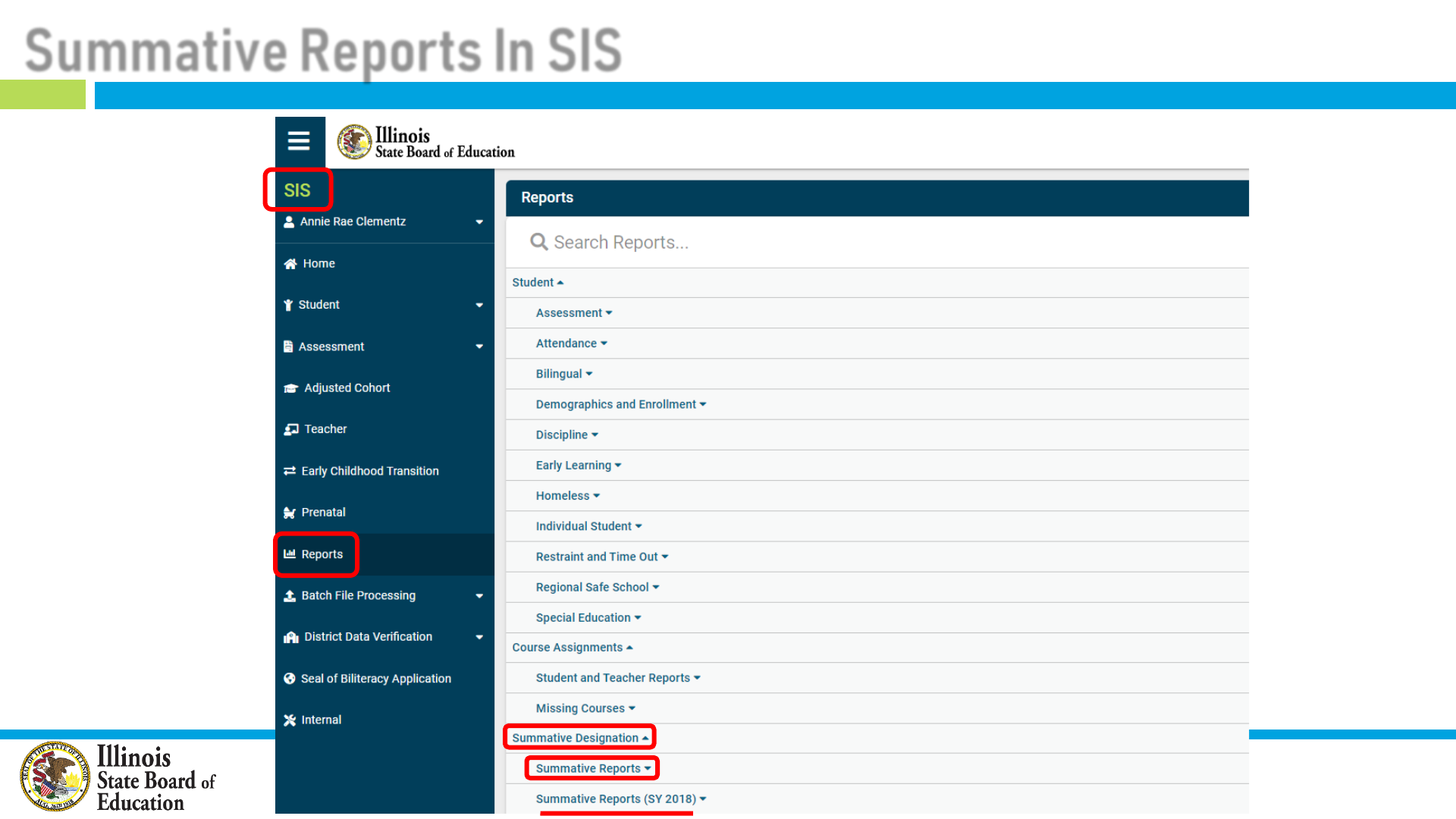
Summative Reports In SIS
33
Only to look at your 2018 data

Summative Reports in SIS
34

Telling Your Story Using the Summative Scores Report
35
Groups
Indicators
1
2
3a
3b

Sample Data–Fazzoul Community Consolidated District #77
36
One of
theses
things is
not like
the
others

Drill In – Where Are the Differences Coming From?
37
Raw Asks: Is 30.6% raw
proficiency ok?
Indicator Score Answers:
It’s on par with state
average performance for
this group.
What about growth?
• >50 = outperforming
the state average,
on average.
• 80% of the state
between 40 and 60.
What is a good
rate of chronic
absenteeism?
Contextual. Goal
is for it to be
similar to other
groups
Why are these
students not
participating at
the same rates
as their peers?
But something
is very different
about math for
this student
group. What is
it?

my
IRC
1. Data Review and
Verification Tool (DRVT)
2. Educator Preview
▪ Look here to find your
preliminary summative
designation
3. Principal Entry Form
▪ Tell your story here

New Tools to Tell Your Story
❑ The Narratives can be accessed through your MyIRC account using the
myPrincipal Entry Form tool.
❑ Character Counts
❑ School Highlights: 350 characters
❑ District Narratives: 450 characters
❑ Summative Narrative: 4,000 characters
❑ Equity Narrative: 4,000 characters
If your tile is greyed out, contact the
MyIRC offices to resolve the issue.

Select a School and Select a Narrative to Edit
41
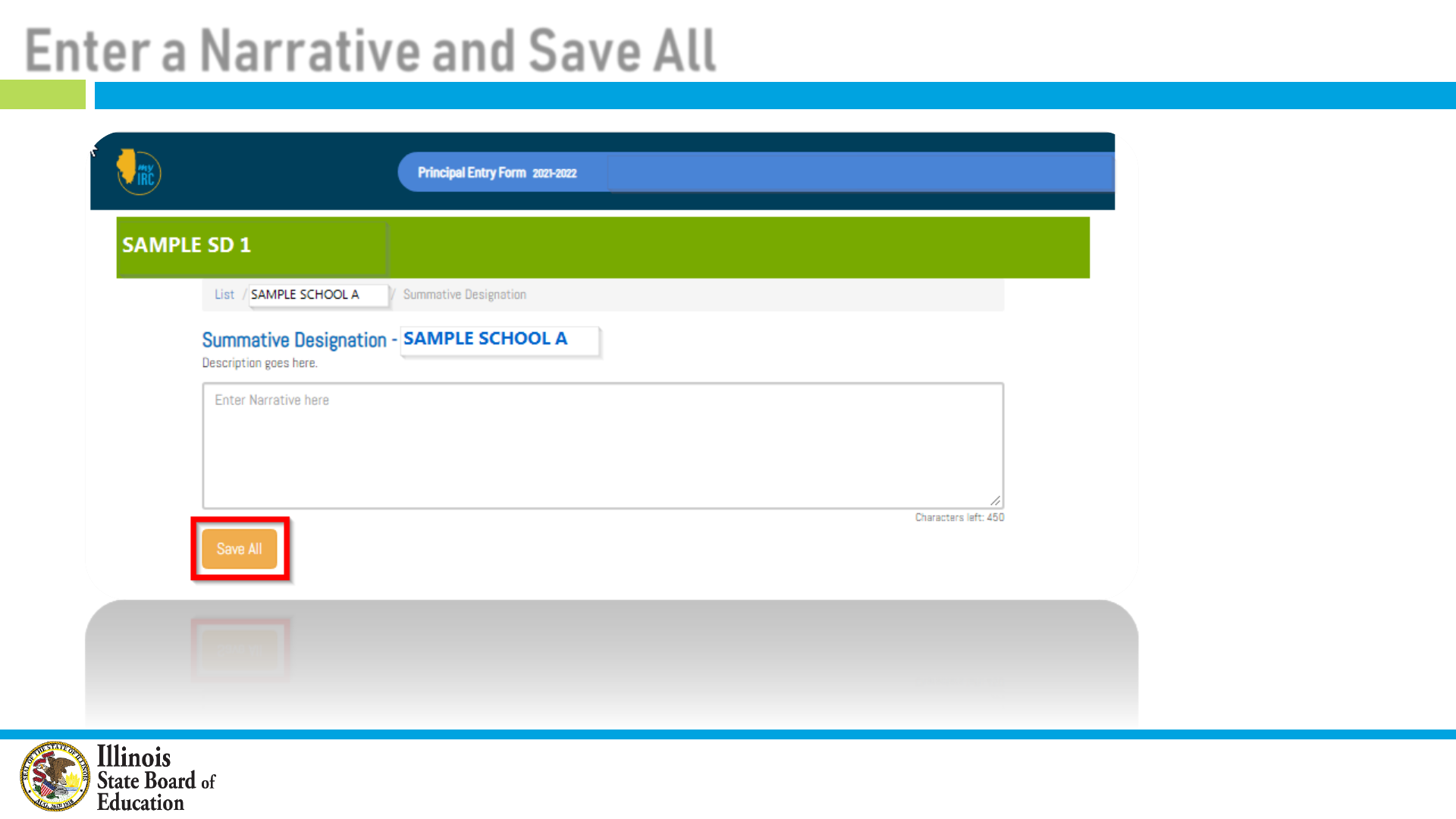
Enter a Narrative and Save All
42
• The narrative you
enter will not be
displayed until
Educator Preview
opens on
October 3.
• In addition, the
narrative you
enter will not be
displayed to the
public until the
Illinois Report
Card is released
on October 27.
The Data Review and Verification Tool (DRVT) will remain
open to allow Districts access to their Report Card data for
assistance in completing their Narratives.

Summative Designation Resources
43
▪ Redesigned site
▪ Individual Indicators button
▪ Want to stay up on coming
attractions? Check out the
IBAM & TAC pages!
▪ General Resources under
the first blue bar.
▪ Year specific resources
organized chronologically

Individual Indicators Page
44
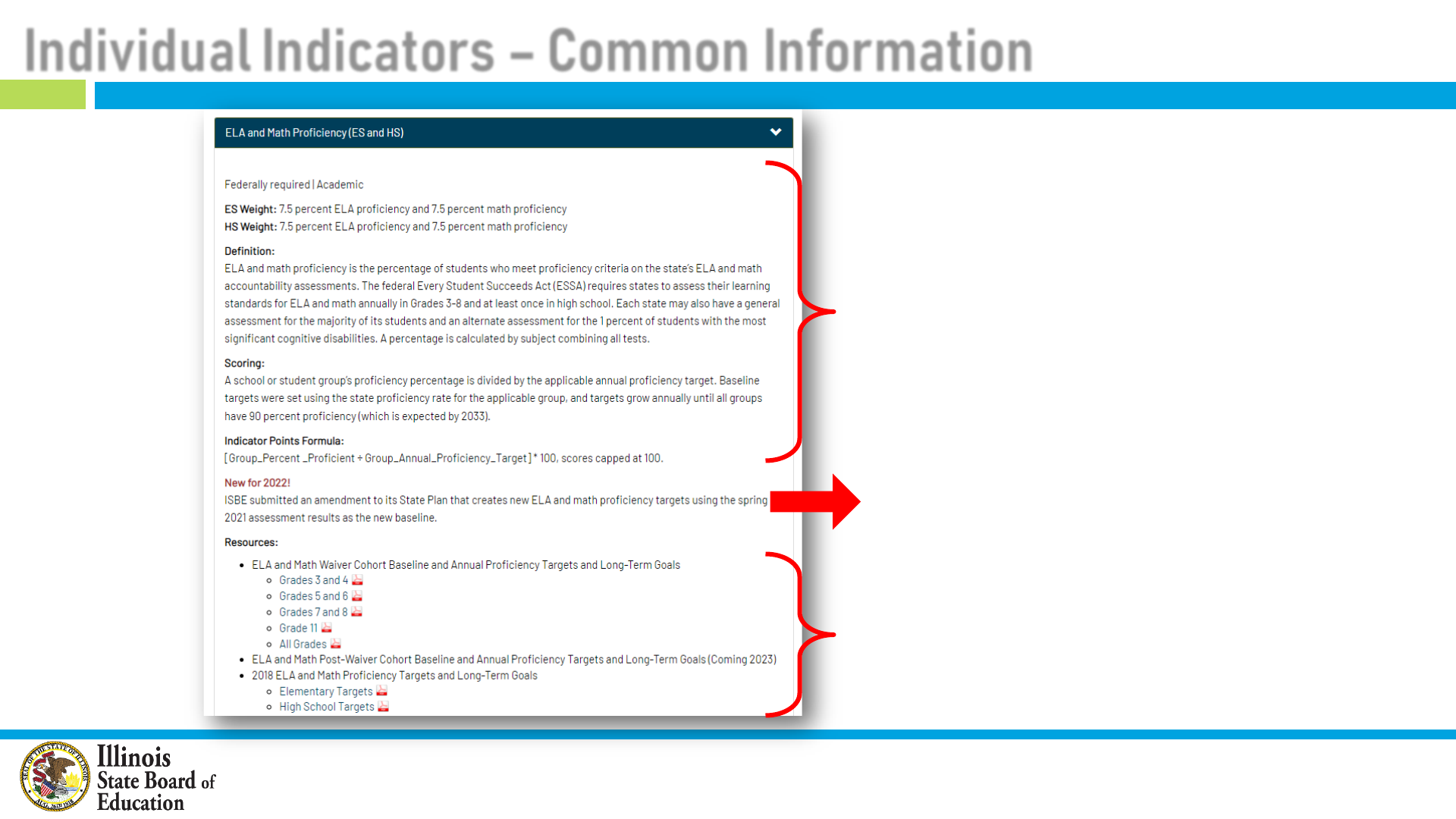
Individual Indicators – Common Information
45
❑ Common information about each
indicator
❑ Federally required or state selected
❑ Weight in each band
❑ Definition
❑ Scoring description
❑ Indicator points formula
❑ New for 2022 (if applicable)
❑ Indicator specific resources such as
interim ELA & Math proficiency targets,
& indicator specific webinars


